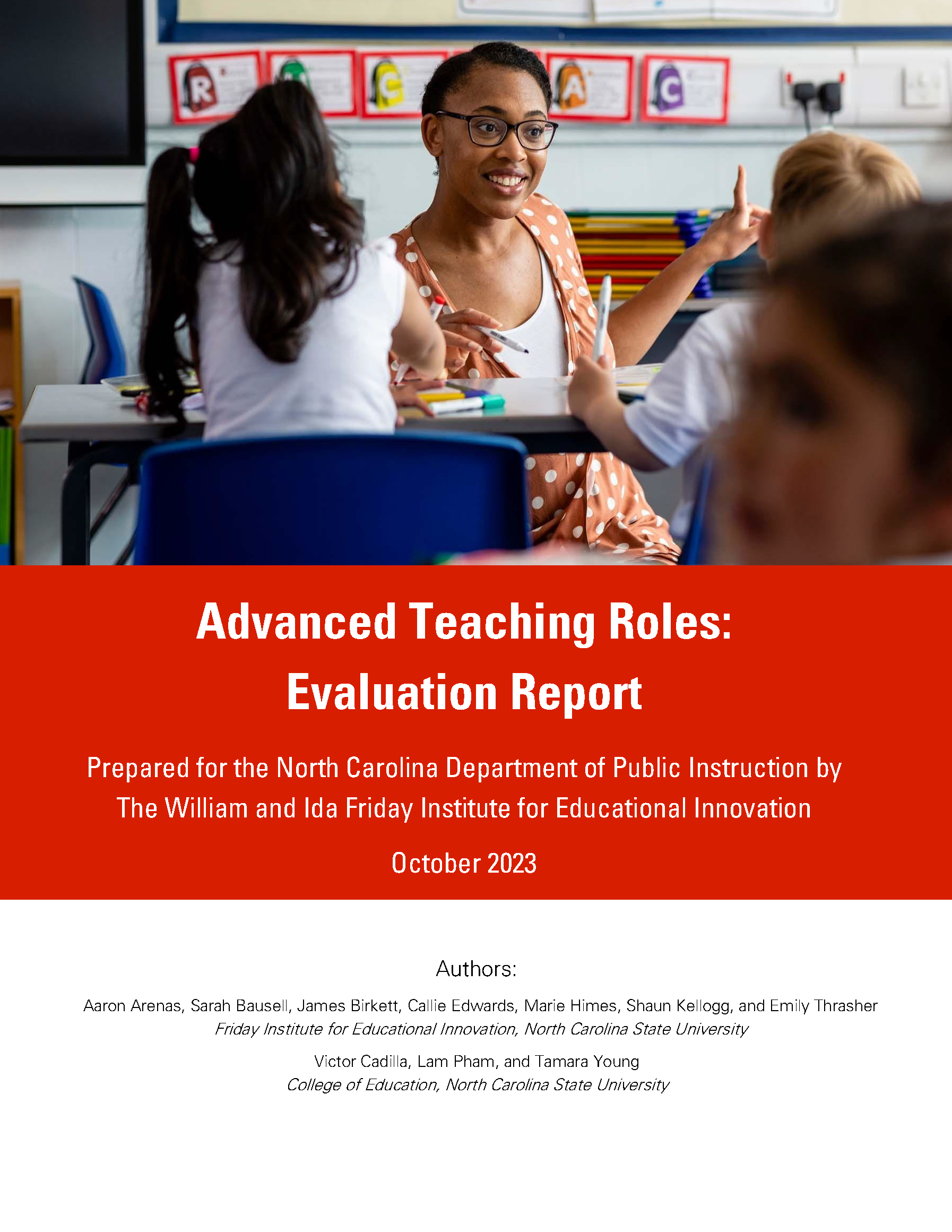
Advanced Teaching Roles Evaluation
Evaluation of the Teacher Compensation Models and Advanced Teaching Roles Program
Program Overview
The purpose of the Teacher Compensation Models and Advanced Teaching Roles Program (ATR) create innovative compensation models that focus on classroom teacher professional growth and allow highly-effective classroom teachers to impact an increased number of students. This can be accomplished by positioning an Advanced Teacher in one of two roles:
- Adult Leadership teachers support a small team of 3 to 8 teachers, assuming responsibility for their students’ academic performance, and providing classroom instruction for at least thirty percent (30%) of the day.
- Classroom Excellence teachers assume and maintains responsibility for at least twenty percent (20%) of additional students as compared to the most recent school year prior to serving in this role.
Ultimately, the goal of the ATR program is to produce measurable improvements in school culture; teacher recruitment, recognition, and retention; the quality of classroom instruction; and, most importantly, student academic growth.
Public School Units (PSUs) receive funding for ATR programs and may designate up to fifteen percent (15%) of the teachers in each ATR school as Adult Leadership teachers and five percent (5%) of the teachers as Classroom Excellence teachers. In compensation for these additional responsibilities, teacher receive a salary supplement of $3,000 for Classroom Excellence teachers and $10,000 for Adult Leadership teachers.
Evaluation Goals
North Carolina General Assembly Session Law 2016-94, Section 8.7, directs the North Carolina State Board of Education to evaluate the Advanced Teaching Roles program described in that law. The law requires evaluation of several components that fall into two broad categories: academic and instructional impact, and impact on the teaching profession. Additionally, legislation directs the North Carolina State Board of Education to contract with an independent research organization to evaluate the extent to which the advanced teaching roles and new compensation plans have accomplished, at a minimum, the following:
- Improvement in the quality of classroom instruction;
- Increases in school-wide [academic] growth or the growth of teachers who are mentored or impacted by a teacher in an advanced teaching role;
- An increase in the attractiveness of teaching;
- Recognition, impact, and retention of high-quality classroom teachers;
- Assistance to and retention of beginning classroom teachers;
- Improvement in and expansion of the use of technology and digital learning;
- Improvement in school culture based on school climate survey results.
The Friday Institute was selected to conduct an evaluation of the ATR program on behalf of the North Carolina Department of Public Instruction (NCDPI). The evaluation is inclusive of legislatively required components and has two broad goals:
- To better understand the implementation of ATR and help identify factors supporting or impeding their success;
- To assess the academic and instructional impact of ATR, as well as its impact on the teaching profession.
2024 Evaluation Report

Key Findings
2024 Evaluation Report
The 2024 evaluation report extends prior evaluation efforts by providing a deeper examination of program implementation during the 2023-24 school year and quantitative estimations of schoolwide and teacher-level impacts for the 2022-23 school year.
Program Implementation
During the 2023-24 school year, 17 grant-funded PSUs fully implemented ATR, with most programs emphasizing elementary schools (65% of ATR schools) and Adult Leadership roles (60% of Advanced Teachers). Most PSUs follow the Opportunity Culture model, though program implementation varies widely in the number of Advanced Teachers, salary supplements ($1,000–$20,000), and staffing strategies. While many ATR programs align with new legislative requirements, district leaders raised concerns about mandates that may complicate implementation. Case studies of Wilson and Pitt County Schools revealed that Advanced Teachers play a critical role in data-driven scheduling, supporting Tier 2 and 3 MTSS students, and fostering professional learning through coaching and external partnerships. The program serves as both a career ladder and lattice, offering leadership growth opportunities while enhancing student achievement, though challenges persist in workload management, scheduling complexity, and sustainability.
Statewide Overview
The findings highlighted below focus on ATR implementation across 17 grant-funded PSUs with special attention to recent changes in legislation related to the roles and responsibilities of Advanced Teachers. This was made feasible by a comprehensive census conducted by NCDPI of teachers participating in ATR that included information such as Advanced Teacher titles and responsibilities, as well as information about the teachers they support. These findings also incorporate data from interviews and surveys conducted with ATR district administrators. Collectively, the research team found that:
- The majority of ATR programs focus on elementary schools, employ Adult Leadership roles, and use similar job titles. During the 2023-24 school year, 849 Advanced Teachers supported 2,461 classroom teachers across 277 schools, 65% of which were elementary. PSUs classified the majority (60%) of their ATR positions as Adult Leadership, a role defined by legislation as a teacher who leads a team of three to eight teachers and shares responsibility for the performance of their students. Most PSUs, 13 of 17, have partnered with Public Impact in the design and implementation of their Opportunity Culture (OC) model. Multi-Classroom Leaders and Expanded Impact Teachers, positions associated with the OC model, account for approximately 82% of ATR job titles across all PSUs.
- PSUs vary widely in size, salary supplements, and strategic staffing of ATR programs. The number of Advanced Teachers within a PSU ranges from as few as three to as many as 416. Salary supplements also vary widely, ranging from $1,000 for Classroom Excellence teachers – defined by legislation as teachers who teach 20% more students – to as much as $20,000 for Adult Leadership teachers. Even among PSUs using similar models, there are differences in how they prioritize, assign responsibilities, and provide supplements for advanced teaching positions.
- District leaders reported that new legislative requirements generally align with existing programs but cited several areas of concern. Across PSUs, many ATR programs and positions already align with new requirements; however, some do not. Several district leaders raised concerns about these requirements and noted that the new requirements for Advanced Teacher positions, such as the requirement that Classroom Excellence teachers serve on team led by an Adult Leadership teacher, may make future implementation more difficult or even infeasible.
District Deep Dives
Highlighted below are findings from in-depth case studies of Wilson County Schools and Pitt County Schools. The aim of these district case studies is to provide a deeper understanding of program design and implementation. These findings from were drawn from observations, stakeholder interviews, surveys and program artifacts. Despite using distinctly different approaches to ATR, both districts shared similar program strengths and face common implementation challenges. Collectively, the evaluation found that:
- Developing and implementing data-informed schedules and interventions is a critical role of Advanced Teachers. Using a wide range of data sources, these schedules allowed Advanced Teachers to meet the instructional needs of students across multiple grade levels, as well as fulfill responsibilities for planning, co-teaching, observations and coaching cycles with their colleagues. Scheduling is an essential but very demanding task. For many, the complexity and volume of scheduling makes it difficult to complete all their duties within the regular school hours.
- ATR has provided students receiving Tier 2 and 3 services through MTSS with greater access to effective teachers. Advanced Teachers reported that their work has helped meet the instructional needs of students receiving Multi-Tiered Support System (MTSS) services. Both districts implemented a variety of strategies to more effectively support these students, such as interventions tailored to specific student needs and modeling interventions for supported teachers.
- Ongoing professional learning and collaboration with external partners are essential to program success. Pitt and Wilson schools provide consistent and varied professional learning opportunities for Advanced Teachers. Though they structure professional learning opportunities differently, they share an overarching orientation toward communication training, enhancing coaching capacities, and relationship building. Both districts also engage third-party teams to offer evaluative feedback and thought partnership to ensure that they continually refine and improve their strategies and practices.
- ATR serves as both a career lattice and a career ladder for teachers. ATR involves training and upskilling educators, preparing them for a variety of roles and responsibilities. Even within established ATR roles, there are opportunities for both lateral and vertical movement. Educators can advance based on their individual goals and the emerging needs of their schools and colleagues. This dynamic framework allows for continuous professional growth, ensuring that educators are well-prepared for leadership positions and can meet the evolving demands of their schools.
Program Impact
The evaluation found significant school-level and teacher-level impacts for the 2022-23 school year, particularly in math achievement and teacher effectiveness. ATR schools showed statistically significant gains in math test scores, equivalent to 1.2 months of learning, with the strongest effects in high schools, while results in English Language Arts (ELA) and science were positive but not statistically significant. Schools implementing ATR for at least five years exhibited stronger academic gains, though effects slightly declined in the sixth year, indicating a need for sustained support. Teachers in ATR schools had higher average EVAAS scores in math, but no significant differences were found for ELA, science, or NCEES ratings. While ATR schools attracted teachers with higher EVAAS scores, retention rates remained similar to non-ATR schools. At the teacher level, preliminary analyses of a small subset of PSUs found that students taught by Advanced Teachers demonstrated significantly larger test score gains in ELA and math, though science results were not significant. Meanwhile, students taught by Supported Teachers performed comparably to those of non-ATR teachers, despite Supported Teachers having lower NCEES scores, fewer graduate degrees, and less teaching experience.
School-Level Impacts
The findings highlighted below summarize quantitative estimates of school-level impacts for ATR schools compared to non-ATR schools that share similar characteristics. To estimate these schoolwide effects, analyses compare the differences in outcomes for schools in the years prior to and after they implemented ATR, with corresponding differences for similar non-ATR schools. State-mandated end-of-grade (EOG) and end-of-course (EOC) exams were used to measure student achievement. For teacher effectiveness, analyses primarily focus on the SAS Education Value-Added Assessment System (EVAAS) and NC Educator Effectiveness System (NCEES). Collectively, the findings suggest that:
- ATR schools produced significant effects on students’ math test scores and positive but not significant results in ELA and science. In math, the evaluation found statistically significant and positive effects equating to a gain of 1.2 months of learning, with the largest effects among high schools. In ELA, the findings suggest ATR is having a significant positive effect in the third through fifth years of implementation, but the overall result is not statistically significant. In science, we also find suggestive evidence of positive ATR effects, but estimates fluctuate more from year-to-year.
- Schools tend to show increasingly positive effects the longer they implement ATR. For all three subject areas, positive effects on student achievement are driven largely by the first two cohorts of ATR schools, which have had at least five years to implement their programs. The findings also suggest that effects across all schools grow up to five years after implementation begins. In the sixth year, ATR schools still outperform non-ATR schools, but show a slight decline, suggesting that additional may be needed support to sustain positive effects after five years, particularly for ELA.
- Teachers in ATR schools are more likely to have higher average EVAAS scores after implementing the program. The evaluation found moderate evidence of positive ATR effects on teacher effectiveness as measured by EVAAS. The average pre-post difference in teachers’ math EVAAS scores is significantly higher in ATR schools than in non-ATR comparison schools. Effects on ELA and science EVAAS scores, as well as NCEES ratings, were not significantly different.
- ATR Schools are more likely to recruit teachers with higher EVAAS scores, but overall retention rates are similar to comparison schools. Driven mostly by EVAAS scores in math, teachers hired into ATR schools tend to have higher average EVAAS scores relative to teachers hired into comparison schools. However, the evaluation found no evidence of differences in teacher turnover rates between ATR and comparison schools. Moreover, teachers who exit ATR schools are not significantly different from teachers who exit comparison schools.
Teacher-Level Impacts
The findings highlighted below extend analyses of schoolwide impacts by examining how the academic growth of students served by ATR teachers compares with students of non-ATR teachers. These results should be understood as preliminary, non-causal estimates and should be interpreted with considerable care. They are based on data from only one year (2022-23) and only a small sample of PSUs and therefore are not representative of all ATR teachers statewide. Collectively, the findings suggest that:
- Students taught by Advanced Teachers demonstrate significantly larger test score gains in ELA and math. Students taught by Advanced Teachers demonstrate statistically significantly higher test score gains in ELA across two different models when compared with students of non-ATR teachers in the same school. In math, the results are positive but only statistically significant in one of two models. Results in science are positive, but not statistically significant using either model.
- Students taught by Supported Teachers have test score gains similar to students of non-ATR teachers in the same school. The academic growth of students taught by Supported Teachers (i.e., teachers who were required to, or elected to, receive support from an Advanced Teacher) are not statistically different from the growth of students taught by teachers not directly supported by an Advanced Teacher. This suggests these students made comparable gains to peers even though Supported Teachers have slightly lower average NCEES scores, are less likely to have a graduate degree, and have fewer average years of experience than the statewide average for teachers.
Next Steps
To strengthen the implementation and impact of Advanced Teaching Roles (ATR), school principals should facilitate data-driven decision-making and provide tailored support for Advanced Teachers through systematic data analysis, targeted professional development, and collaboration opportunities. District leaders should clarify ATR roles, ensure sufficient release time, and expand retention strategies beyond ATR, including mentorship programs and improved working conditions. State leadership must secure sustainable funding, align legislative requirements with district realities, and enhance collaboration among PSUs. Additionally, institutions of higher education should adapt Educator Preparation Programs (EPPs) to better equip future educators for ATR, emphasizing team-based teaching models and shared instructional responsibilities.
Program Recommendations
The following recommendations are intended to provide actionable steps for principals, administrators, and state leadership to promote successful strategies and address implementation issues highlighted above:
- School principals should foster data-informed decisions and tailor Advanced Teacher support. Principals should help establish systematic data analysis processes and routines, enabling Advanced Teachers to lead more effective interventions, team discussions, and coaching sessions. Principals should also provide more tailored professional development opportunities and foster collaboration opportunities for Advanced Teachers to continuously grow and share best practices.
- District leaders should ensure role clarity and broaden retention strategies. District leaders should provide clear role definitions and sufficient release time for Advanced Teachers, allowing them to effectively mentor, co-teach, and lead professional development. Additionally, districts should consider broader retention strategies beyond ATR, such as mentorship programs, improving working conditions, non-monetary incentives, and gathering regular feedback from teachers.
- State leadership should provide sustainable funding, support alignment, and foster district collaboration. State leadership should work to ensure reliable and sustainable funding for ATR salary supplements and program costs, ensure that legislative requirements and the reality of district contexts are in sync, and provide more opportunities for collaboration among PSUs.
- Institutions of Higher Education should enhance connections between Educator Preparation Programs (EPPs) and ATR. ATR signifies a shift towards team-based teaching methods that incorporate new collaborative teaching models and shared responsibility for student outcomes. EPPs should consider their curricula and training to better prepare future educators for ATR.
Explore More
Related Projects
Friday Institute Project Team
Past Team Members
Project Sponsor









